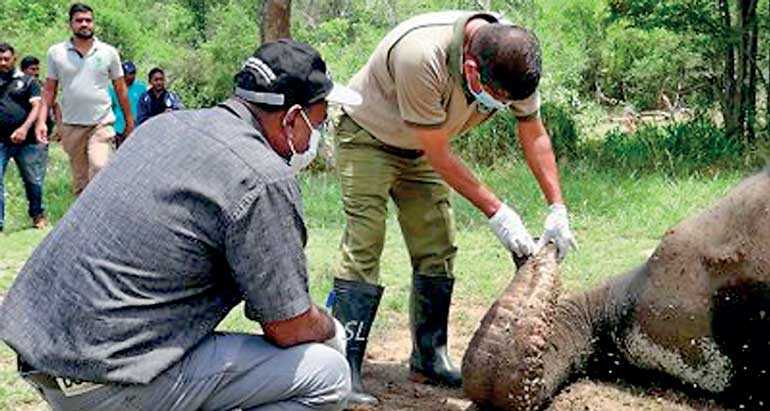Tuesday Nov 04, 2025
Tuesday Nov 04, 2025
Monday, 30 September 2019 01:12 - - {{hitsCtrl.values.hits}}

By Shanika Sriyananda
The wildlife officials, who concluded the post-mortem into sudden deaths of seven elephants, said yesterday that they had found one male carcass among them and the causes of deaths still remained a mystery.
DWLC Senior Veterinary Surgeon Dr. Chandana Jayasinghe said the DWLC team of four veterinary surgeons had concluded the examination to determine gross pathological changes and also collected samples from the seven carcasses at the post-mortem held yesterday.
“We need to get the lab diagnosis and the final outcome of the post-mortem to prove the causes of deaths. We are continuing with our probe,” he told the Daily FT.
DWLC Anuradhapura region Chief Veterinary Surgeon Dr. Jayasinghe said the seven carcasses were found between the borders of Mahaweli region and the Wayamba Province and the elephants were in the reproductive age between 20 to 35 years- old.
He said there were no pregnant elephants among dead but they found a four year-old baby male elephant which was refusing to move from its dead mother.
“We have already sent the blood samples to the Government Analyst Department (GAD) to do the laboratory test to check whether the dead bodies contain any poisons,” he said adding that at the moment the only possible reason for seven deaths can be attributed to poisoning.
Dr. Jayasinghe said since such an incident had never happened, they had to look into all possible causes seriously as the majority of them are female elephants.
According to Dr. Jayasinghe it could be a natural or a man-made cause but it was difficult to suspect it as a ‘people involved crime’ as the majority of the elephants found dead were females, which would normally remain with the herd looking after the calves and not having conflicts with villagers.
Conservationist and Centre for Conservation and Research Head Dr. Prithiviraj Fernando requested the authorities to carry out a fully-pledged probe into the controversial incident that has killed seven elephants. “It is difficult to kill female elephants in a herd and mostly the villagers are angry with male elephants, which storm into villages and chena cultivations searching for food but the females are mostly eating grass or other plants and do not go out of their surroundings,” he said.
Meanwhile, he said it was very strange to claim that it could happen due to poisoning.
“Even if some group of people want to take revenge from elephants for causing destruction, it is not possible to poison elephants as they had to use a huge amount of poison to water resources to kill them. And how to target only females also remains a question. It is also not possible to poison water during a rainy season,” he explained.
Dr. Fernando said this was similar to the number of elephant deaths reported in the rainforests of Boreno in the Malaysian State of Sabah, last year.
He suggested to conduct a complete post-mortem on each of the elephants to look into symptoms, take samples for toxicology analysis and also to send them specialised laboratories in the UK and US to detect the cause or causes for those deaths.
“I do not know whether Sri Lanka has technology to prove the real causes of their deaths. However, proving the real cause is very vital as female elephants dying will have a big impact on the already dwindling elephant population in the country, which has estimated 2,000 females out of a 6,000 elephant population,” he said, adding that a female elephant can give birth to eight babies during her reproductive age.
Dr. Fernando said the incident was very mysterious as if it happened due to poison in the water resources, the young elephants could also be among the dead.
“Babies and young elephants always roam together with their mothers and they come to drink water together. But there were no young elephants among dead. They die quicker than adults if they are poisoned. And there were no other animals were also found dead,” he noted.
According to Dr. Fernando, this incident needs to be considered as a crime scene investigation and the DWLC needs to contact some international wildlife experts to identify the cause of death soon.
When contacted DWLC Director-General Chandana Sooriyabandara, he said there was no need to test the samples in an international laboratory as the required technology was available locally. “We would hand over the samples taken at the post-mortem to the GAD, Faculty of Veterinary Medicine and Animal Science of the Peradeniya University and the Veterinary Research Institute to conduct scientific analysis to find the causes of deaths,” he said adding that the DWLC would be able to conclude its investigation within a week.
Over 50 DWLC officials together with Army soldiers and Police had conducted an operation in the surrounding areas, yesterday, to find whether more carcasses of elephants and other animals had also been affected due to the mysterious cause of death.
The DWLC Chief said they commenced its probe into the seven dead elephants following the instructions of the Kekirawa Magistrate Courts, where the DWLC had reported about the death of seven elephants.